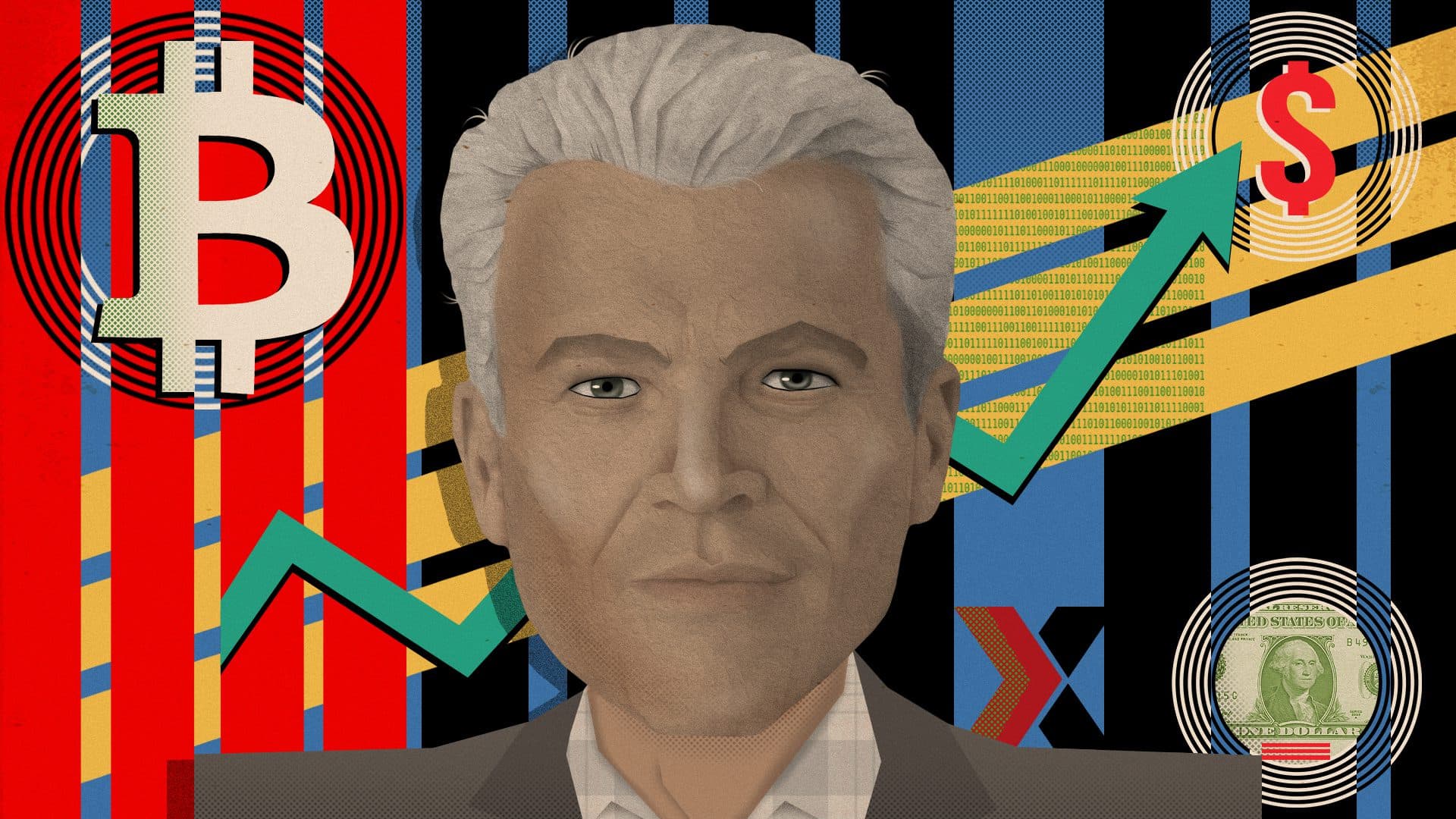Big Money Crypto Traders Still Bullish on BTC and ETH, LMAX CEO Says
Institutional crypto exchange LMAX Digital marked its biggest trading day of the year last week as markets bounced

LMAX CEO David Mercer | Blockworks exclusive art by Axel Rangel
- LMAX Group CEO David Mercer believes crypto could overtake gold within the decade
- The firm’s institutional clientele showed strong conviction in bitcoin and ether during the recent chaos
Institutional crypto exchange LMAX Digital just recorded its largest trading day for the year — fueled by bullish sentiment among the world’s top traders.
According to LMAX Group CEO David Mercer, the exchange’s whale-like clientele appear relatively unscathed, despite chaos triggered by the collapse of algorithmic stablecoin UST and its sister token, LUNA.
Mercer told Blockworks $3.3 billion in trades flowed through LMAX Digital last Thursday.
“My institutions traded more than ever,” Mercer said. “They’re the biggest proprietary trading firms in the world, in Chicago, New York, Amsterdam and London. Their conviction in bitcoin for certain remains undented, with their belief in ethereum apparently the same.”
Mercer declined to specify the firms in question. But the likes of Jump Trading and DRW’s Cumberland fit the profile.
For scale, LMAX Digital saw $1.5 billion daily on average last year, with its top day reaching $6.6 billion on May 19, when bitcoin collapsed from $59,000 to $34,600.
In any case, Mercer said uncertainty and fear pushed LMAX Digital volumes higher. Mercer saw institutions “fleeing to quality,” as his platform “doesn’t dabble in some of the more experimental coins.”
Last Thursday, both bitcoin and ether — the largest cryptocurrencies by market capitalization — rose about 6% during intra-day trading, although some native tokens of crypto exchanges performed better.
Mercer believes Terra’s demise has a hidden silver lining.
“I might have a slightly different view to most people,” Mercer said. “I mean, people use crypto in a very wide framework. To me, bitcoin is half the market, because as a currency, it’s very stable and robust.
On the other hand, Mercer dubbed decentralized finance (DeFi) an ecosystem of science experiments.
“Pegs generally break, especially if they’re flawed,” Mercer said, citing sudden devaluations of numerous currencies over the course of history, including George Soros’ successful “attack” on the British pound in 1992, the Euro-Swiss franc collapse in 2015 and the Argentinian peso in 2002.
Still, Mercer wouldn’t call algorithmic stablecoins such as Terra dumb ideas. It was a good idea, backed by some very great minds, he reasoned, “but it didn’t work, and it was upset by normal market dynamics.”
The case for collateralized (and audited) stablecoins
Instead, Mercer is a fan of collateralized stablecoins, such as Circle’s offering, USDC. LMAX Digital accepts USDC.
LMAX Digital combines USDC with USD in one order book and handles margin trade in the stablecoin.
“Don’t get me wrong, probably 97% of my trading is crypto-to-fiat,” Mercer said. “But some customers arrive and they say, ‘Look, I’ve got this USDC. It’s easier if it’s in USDC, rather than US dollars.’ That’s fine — I accept USDC and can transfer it immediately, to the extent that those order books are the same.”
But why not USDT? Mercer cited Circle attestations via accounting giant Grant Thornton, which states that every USDC is backed by a US dollar or US Treasury. This doesn’t make USDC a “particularly sexy stablecoin,” Mercer said, but it is collateralized, liquid, and “one is equal to one.”
USDC’s well-documented collateralization allows LMAX Digital to confidently merge its fiat dollar order books with its USDC books.
“We don’t offer Tether today for one simple reason: that one-to-one ratio is not guaranteed,” Mercer said.
Tether constantly assures the market each USDT is properly backed by a mixture of money market deposits, corporate bonds and the like, but Mercer doesn’t have full faith in the reports Tether produces.
The LMAX chief said Tether needs more transparency before he would accept USDT.
“I’m a simple guy,” he said. “I’m in traditional markets. Tether is telling me there’s $70 billion USDT in circulation? Just show me the portfolio. I don’t understand why that can’t happen. I just want $1.”
As such, Mercer said he would happily embrace CBDCs, or central bank digital currencies — digital fiat issued by central banks. Fiat is too clunky for crypto markets, and he considers reducing friction in the ecosystem to be the primary use case for stablecoins and CBDCs, saying “it should oil the wheels.”
Bullish on crypto’s future
Finicky stablecoins aside, Mercer is remarkably bullish on crypto’s future, although digital asset trade makes up a small percentage of LMAX Group’s revenue.
Six exchanges fall under the LMAX Group umbrella. LMAX Digital, the institutional crypto platform, represented 15% of LMAX’s total volume, but 40% of revenue last year.
Overall, the group recorded $110 million in revenue from about $6 trillion foreign currency volume, with crypto contributing about $550 billion.
Remarkably, LMAX Digital’s BTC-to-USD pair was its eighth-biggest currency pair across the entire group — euro-to-dollar was No. 1, dollar-to-yen was second, and sterling-to-dollar was third.
By 2025, Mercer believes it will be possible to trade bitcoin against everything: gold, the S&P, euros, the FTSE, nickel and aluminum, “just the same way you can trade dollars against everything.”
He also predicted crypto will overtake gold within the decade. Crypto is currently worth about $1.5 trillion. Gold is between $10 and $12 trillion.
Get the news in your inbox. Explore Blockworks newsletters:
- The Breakdown: Decoding crypto and the markets. Daily.
- 0xResearch: Alpha in your inbox. Think like an analyst.






